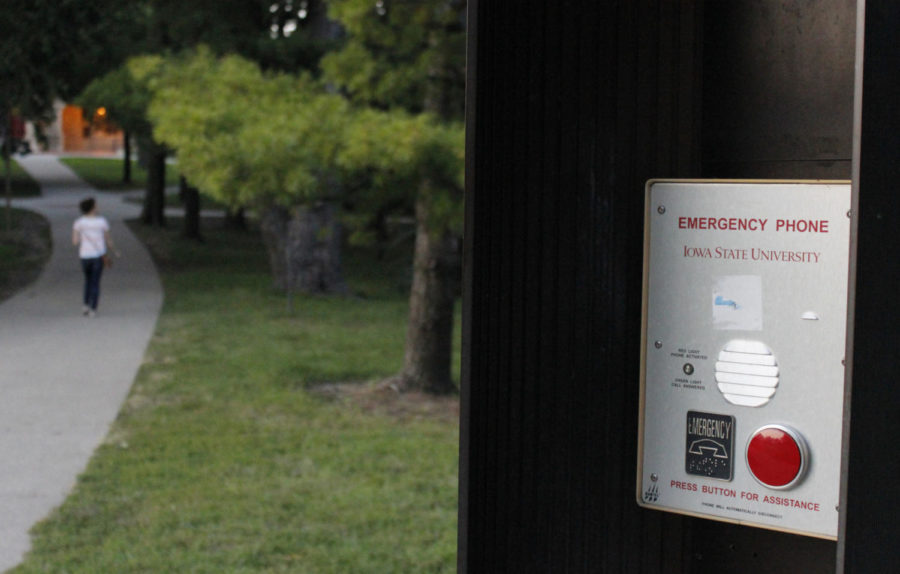ISU safety departments give tips on being prepared, safe on campus
Caitlin Ellingson/Iowa State Daily
The Environmental Health and Safety building is located northwest of campus, with a mission to protect students and the environment at Iowa State through safety and preparedness. Emergency phones have been installed to give added protection to students, which can be found throughout campus.
September 21, 2014
Three public safety departments are focusing on safety and emergency awareness and practices as part of September’s Emergency Preparedness Month.
The Environmental Health and Safety Department at Iowa State works with the ISU Police Department and the Emergency Management Agency of Story County to keep the city of Ames updated on preparedness techniques and information.
Steve Simpson is the director of the environmental health and safety department on campus.
Simpson’s department recently released a video to show students how to act during any type of campus emergency. Simpson said he believes that campus is fully prepared for emergency situations.
“We have a lot of resources at hand, and people are trained well at responding,” Simpson said.
In addition to working with the local fire department and emergency responders, another resource that Simpson’s department works with is ISU Police.
The on-campus police department, which employs 35 state-certified police officers, assigns liaison officers such as Anthony Greiter to each residence hall on campus. The department prides itself on making sure that students know that these liaison officers are approachable and that they can report incidents to them.
“We’re not robots,” Greiter said. “We’re normal people, we’re nice people, we go home to families at the end of the day. You can talk to us.”
Keith Morgan, emergency management coordinator for Story County, said Iowa State is the second largest jurisdiction that he oversees. Morgan’s job is to prepare his jurisdictions for potential emergency situations.
“We look across the entire county and look across the environment for both natural and manmade threats that are out there,” Morgan said.
ISU Police and environmental health and safety department offer Violent Incident Response Training, which is an interactive training program that shows students, faculty and staff how to act during any type of violent incident on campus. Being prepared as an individual is just as important as being prepared as a campus, Greiter said.
“A lot of people say that you rise to the occasion, but we know that’s not true,” Greiter said. “You fall to the level of your training.”
The training can accommodate groups from five to 150 people and ISU Police constantly has requests from students to host training sessions.
“People that go through [the training] start to realize that they can control their environment,” Morgan said.
Iowa State offers other safety services for students, faculty and staff.
There are 17 emergency phones throughout campus for students to use if they ever feel unsafe. Pushing the red button notifies police and officers are sent to that location.
ISU Alert is a communication system that notifies students, faculty and staff of an emergency that may be dangerous to the community through a phone call, text or email.
The Safety Escort Program can be called between 6 p.m. and 6 a.m. if students feel unsafe walking by themselves across campus. A student employee will escort the caller anywhere on campus or within the greek community.
To be prepared for a range of emergencies, students are encouraged to follow a three-step process: make a kit, have a plan and be aware.
By following these three steps, students can be more prepared in case of an emergency. A few recommended items to have in a kit would be food and water, a wallet, identification, keys to a vehicle and any last minute items that could be grabbed.
Simpson said that although these things are important, they are not the only things that could benefit students in an emergency situation.
“Being prepared is more than just the kit. It’s knowing what would you do, where would you go if you needed to be out of your apartment,” Simpson said.
The second step is to have a plan. Most residence halls on campus will have a set evacuation plan, but it isn’t a bad choice to make an individual plan. Grieter recommends knowing where all exits are at all times. In a dangerous situation, he said to view windows as exits.
The last step is awareness. With students walking to and from classes with heads down and focusing on their cellphones or listening to music, they are not as aware of their surroundings, Greiter said.
“How are you supposed to be aware of what is happening around you if you can’t hear it?” he asked.
Even though September is when we draw attention to emergency preparedness, the emergency preparedness departments on campus said students should to strive to be prepared every day of every month for all types of situations.
“If we work together, we can save lives,” Simpson said.







